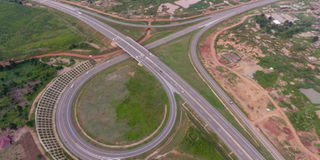Prime
What Uganda spends on debt and who gets paid

Costly. Kampala-Entebbe Expressway is one of the big projects financed by a loan from China. The project is one of those that raised the stock of debt from China, which now accounts for 75 per cent of Uganda’s bilateral foreign debt stock. FILE PHOTO
What you need to know:
- Huge. Debt servicing is taking up more than 50 per cent of the country’s earnings.
- The rest of the money was paid to bilateral creditors and commercial banks who, respectively, account for 34 per cent and 0.63 per cent of Uganda’s external debt. The bilateral creditors were paid Shs184,632.26b and the commercial banks Shs3,973.50b.
A report by Parliament’s Committee on National Economy released this week shows that Uganda’s income has not been growing fast enough to match our debt servicing requirements. It shows that debt servicing is taking up more than half of the country’s earnings.
“Debt service of Uganda’s external debt is on the rise and outstripping growth of the country’s income, currently at 60 per cent. This poses risks for future debt repayments, especially as the country continues to acquire external debt at less concessional terms, especially to finance the oil development programme,” the report reads, in part.
The report indicates that total expenditure on debt servicing rose by 129 per cent in the Financial Year 2017/2018. The amounts paid out rose from $120.62m (about Shs439b) in the Financial Year 2016/2017 to $275.75m (about Shs1 trillion) in the Financial Year 2017/2018.
The debate on debt, especially on whether the country’s borrowing is sustainable, remains divisive, with the government insisting that we have not crossed the 50 per cent debt-to-GDP ratio, which international financial organisations say is the threshold for debt sustainability for poor countries.
As this debate rages, we take a look at how much Uganda spends on debt repayment, and who gets paid. A report on public debt, guarantees, other financial liabilities and grants for last financial year, produced by the Ministry of Finance, has details.
It shows that the government paid out a total of Shs627b to creditors, out of which Shs266b or 42.45 per cent, was paid to PTA Bank, making the regional bank the biggest single recipient of debt financing funds from Uganda.
Established in 1985, the Eastern and Southern African Trade & Development Bank, formerly the PTA Bank, is a multilateral treaty-based development financial institution.
Exim Bank of China was the second highest paid creditor last financial year, taking Shs117b or 18.72 per cent, while the International Development Bank (IDA) of the World Bank came third with Shs102b or 16.24 per cent of the overall amount that was paid out to all creditors.
Debt distribution
The report shows that 66 per cent of Uganda’s debt, which stood at $7.66b by end of December 2018, is owed to multilateral creditors, while the bilateral creditors are owed 34 per cent.
According to government figures, the multilateral creditors were paid a total of Shs438m out of the Shs627b, which accounts for 70 per cent of what was paid out.
The multilateral debtors include the International Development Agency (IDA), Asian Development Bank (ADB), French Development Agency (AFD), the Arab Bank for Economic Development in Africa (BADEA) and the European Investment Bank (EIB).
Others are the Islamic Development Bank (IDB), the Nordic Development Fund (NDF), the Opec Fund and the International Fund for Agricultural Development (IFAD).
The rest of the money was paid to bilateral creditors and commercial banks who, respectively, account for 34 per cent and 0.63 per cent of Uganda’s external debt. The bilateral creditors were paid Shs184,632.26b and the commercial banks Shs3,973.50b.
The bilateral creditors are Exim Bank of China, Exim Bank of South Korea, the Kuwait Fund, Nigeria, Saudi Arabia, Iraq, Abu Dhabi, Austria, France, Japan through the Japan Bank for International Cooperation (JBIC) and Japan International Cooperation Agency, Germany and UK Export Finance (UKEF).
Bilateral lenders
According to the documents, the financing of Karuma and Isimba Hydro Power Stations and funding for roads such as the Entebbe Expressway, substantially raised the stock of debt from China. It now accounts for 75 per cent of Uganda’s bilateral foreign debt stock, for which it has since come under criticism from sections of the populace.
Last month, Opposition leader Kizza Besigye took a swipe at the government for borrowing from China, saying the country ought to be more responsible in the manner in which it handles the government’s new found appetite for borrowing, especially in light of the fact that most of the money is squandered.
“Lenders have a responsibility. We must sound a very clear warning to, especially, our friends the Chinese,” he said on July 25, while giving what he described as the State of the People Address.
“Uganda was forgiven all its debts in 1992, but today, every Ugandan has a debt of Shs1m and the foreign debt is growing. It is 42 trillion and counting. Debt is not a bad thing if you are to put to it productive use, but part of it is stolen and some of it is used to beat us,” he added.
Undisbursed loans
The report by Parliament’s Committee on National Economy indicates that there was a reduction in the amounts of borrowed money that has remained in the hands of the creditors due to, among other things, failure by the implementing agencies to absorb the funds.
The stock of undisbursed loans dropped from $4.48b as at December 2017, to $4.05b as at December last year.
It attributed the decrease to improved performance of project, but the fact that government continues to pay interest in the form of commitment fees to the creditors, is a big minus.
The majority of undisbursed loans, 61 per cent, is in the hands of multilateral creditors, 38 per cent in the hands of bilateral creditors and 1 per cent in the hands of commercial banks.
Loans, according to the document, remain undisbursed either because certain conditions precedent to the disbursement have not been fulfilled or because of delays in the procurement process. There are also cases involving projects whose implementation is conducted over a lengthy period of time and others where no requests for disbursements have been filed in line with the implementation plans.
Some of the projects named as partially responsible for the undisbursed loans include large infrastructure projects such as Kabaale International Airport, Busega-Mpigi Expressway, the Entebbe Airport Expansion project and the various power grid extension projects around the country.




